As winter solstice approaches, cold weather has enveloped the country – earlier than usual and colder too than in recent years. The cold front changed our sunny winter days to overcast, and last night brought some rain.
Here in KwaZulu-Natal (KZN) winter is our dry season so any rain is welcome, but coupled with the cold it means that there is no chance of warming up in the morning sun. I think it was not only the vervet monkeys who visited our garden this morning who found that tough.
The overcast skies and the rain that caused the vervets monkeys to huddle together are in strong contrast to the previous winter days as evidenced in the photo below of vervets engaged in relaxed grooming in winter sunshine last week.
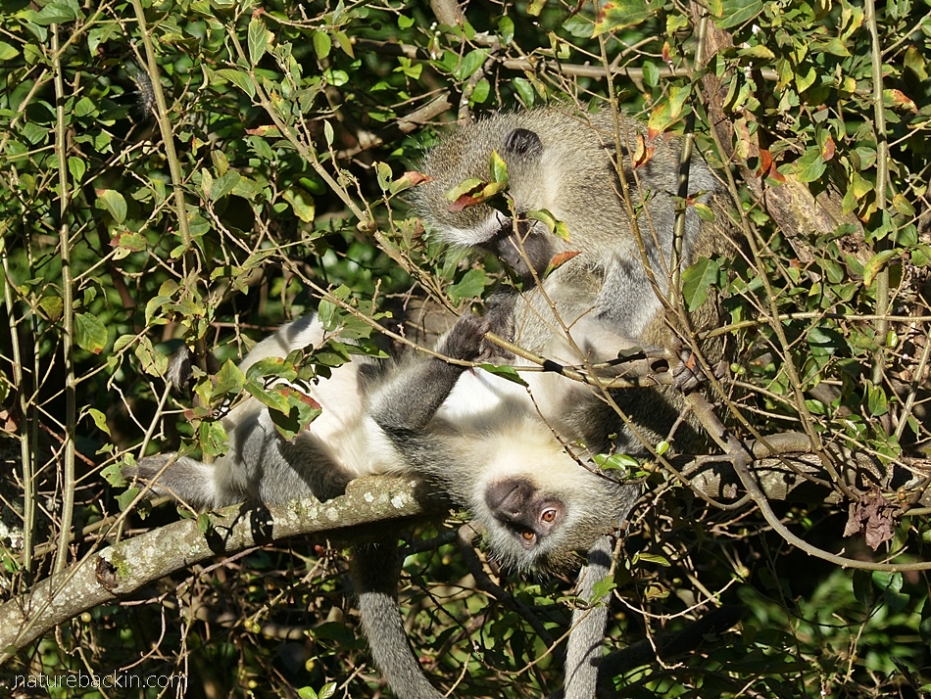
The birds are relatively reticent this morning without the sun. In the autumn and winter months we are visited by bronze mannikins (see below) as well as red-backed mannikins, and in the early mornings they can often be seen in the trees on bare branches taking in the sunshine.
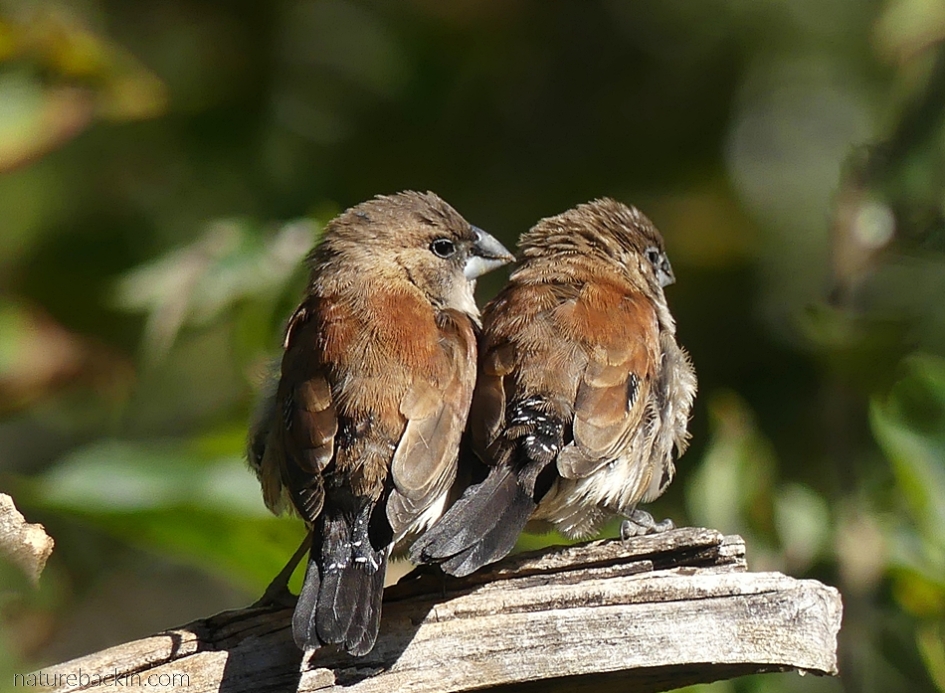
Where we live in KZN the indigenous deciduous trees change colour rather quickly and drop their leaves comparatively suddenly. The fall of leaves is often in response to the first really cold weather and in many winters this may be only late in the season. The current cold weather, with snow in some of the mountain regions, which we are experiencing now in June is unusually early.
Although we do not have the spectacularly colourful autumns that I associate with the northern hemisphere, we do have many lovely winter flowers – often brilliant in the winter sunshine – to brighten up the dryness of winter.
Some of these flowers I have featured before, but they are all worth another look. All of these photos of flowers (and some leaves too) were taken in our garden during June this year. The ones in the sunshine were taken last week, and the others were taken yesterday when it was overcast, and a few this morning when it was still raining lightly.
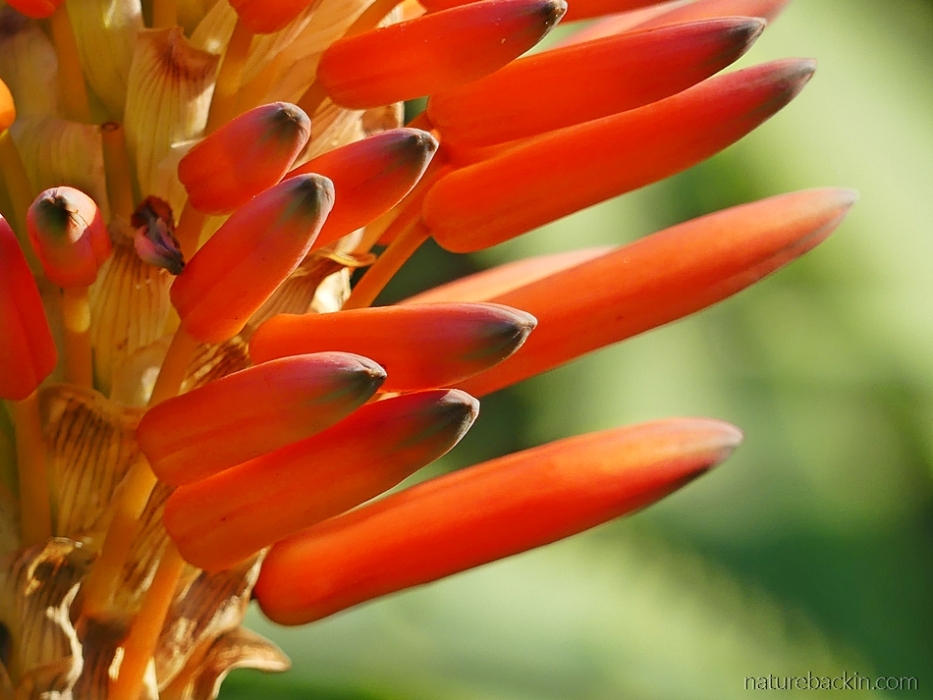
A close-up of unopened flowers of the Krantz aloe (Aloe arborescens)
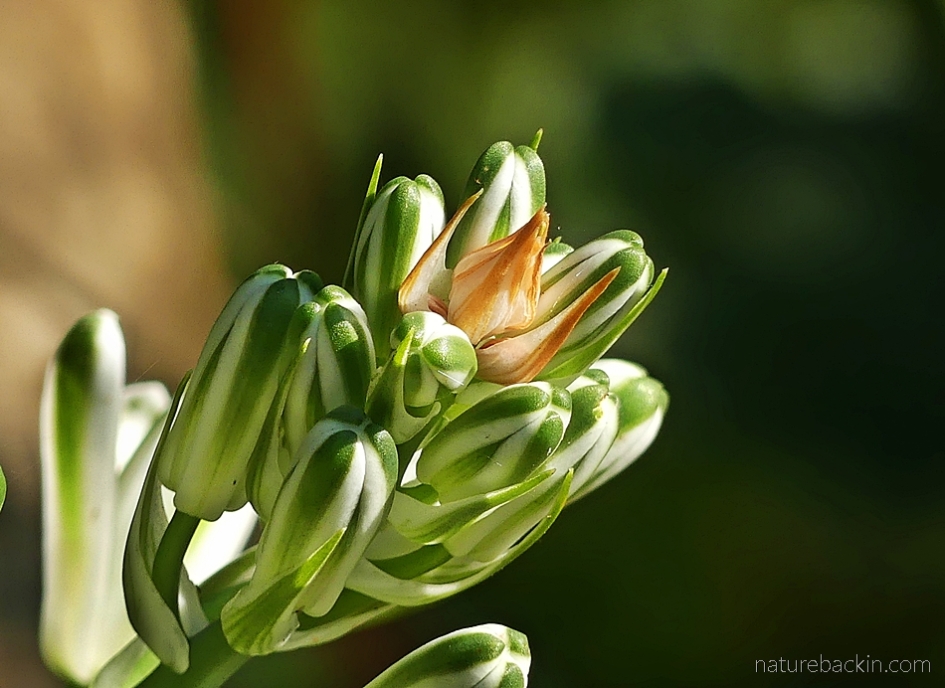
The green and white flower buds of one of the Albuca species
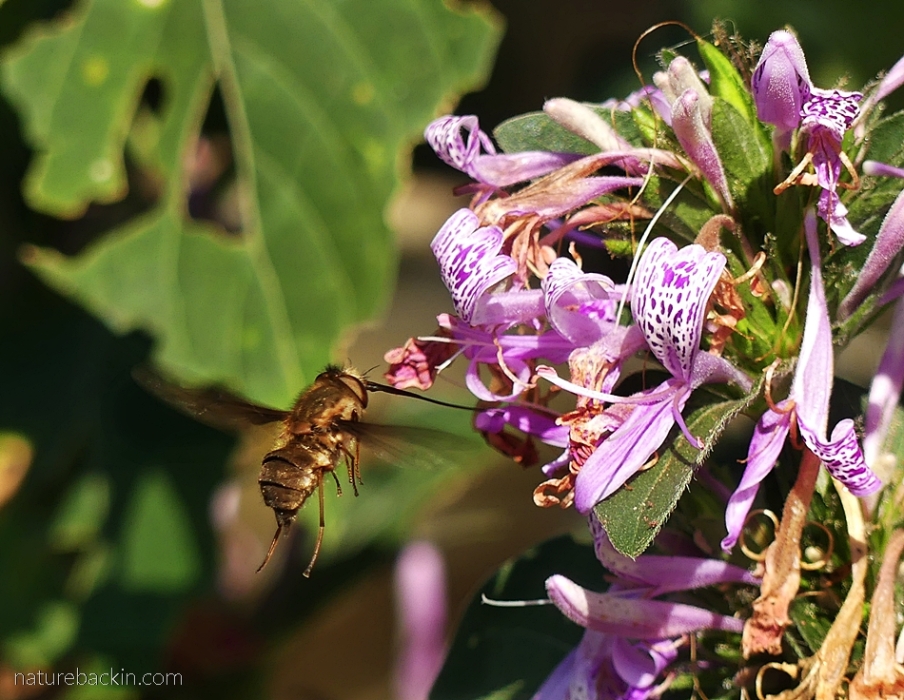
Tangle-veined flies (of the Nemestrinidae family) are often seen nectaring at the autumn-into-winter flowers of the ribbon bush (Hypoestes aristata)
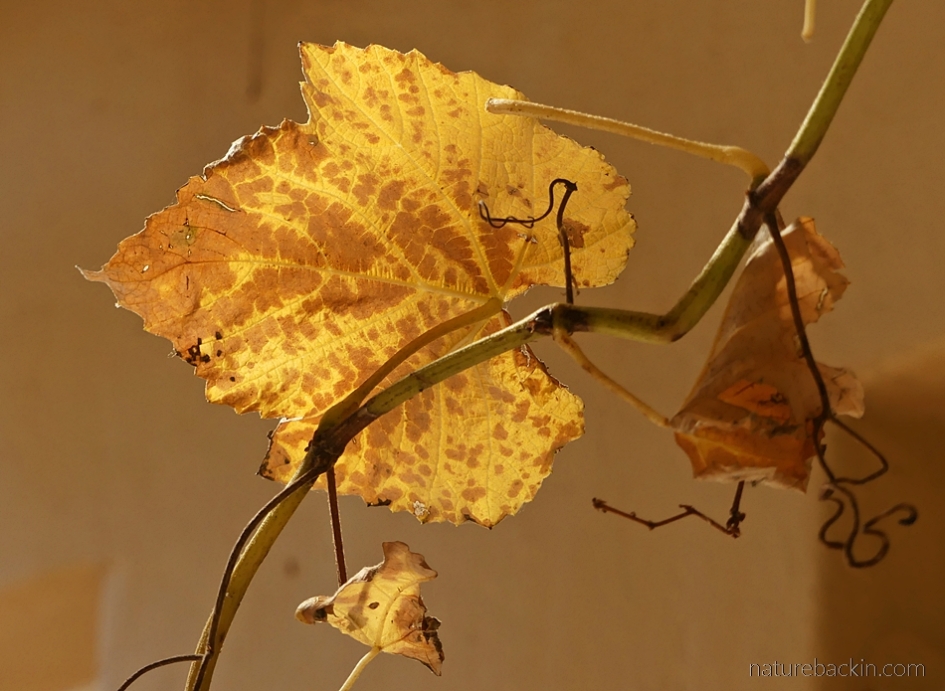
We have a non-indigenous grapevine over our back deck – perfect for shade in summer, and it helpfully sheds its leaves starting in the autumn to let in the sun in winter
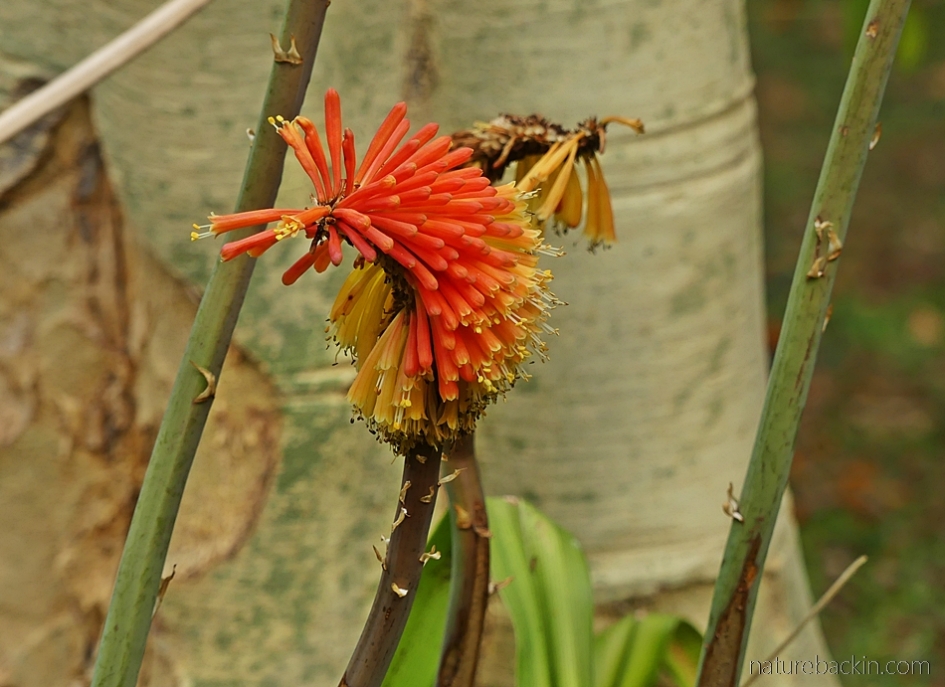
Past their best and a little eaten by something these flowers of the Kniphofia praecox show up brightly against the pale yellow bark of a fever tree (Vachellia xanthophloea previously Acacia xanthophloea)
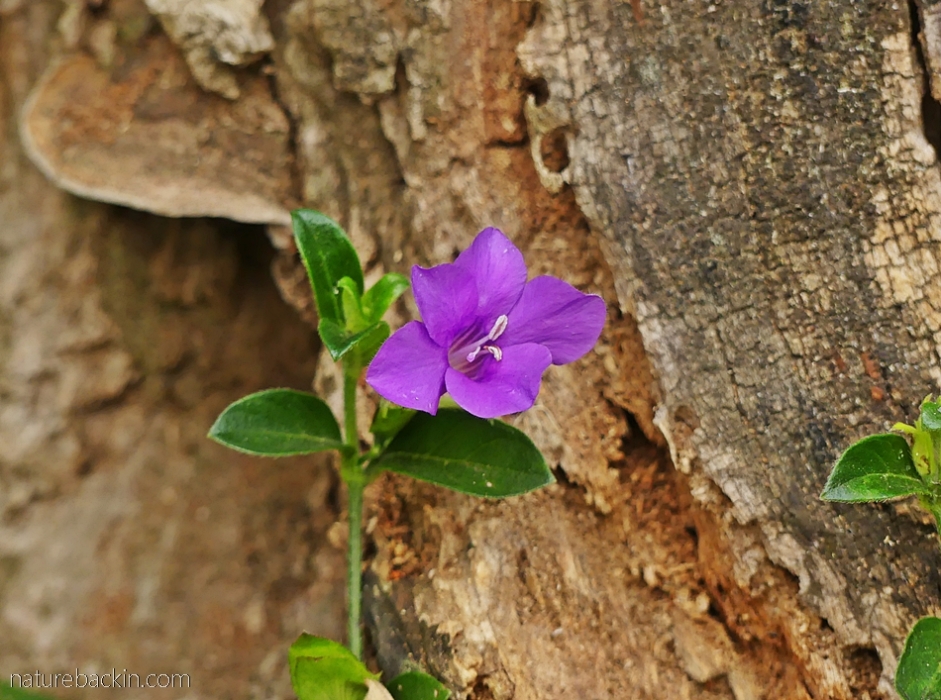
Glowing against dead wood in the light of an overcast sky, is a lovely purple flower of the bush violet (Barleria obtusa or possibly Barleria repens)

Standing tall against the cloudy sky are flowers of the fence aloe (Aloiampelos tenuior, previously Aloe tenuior)
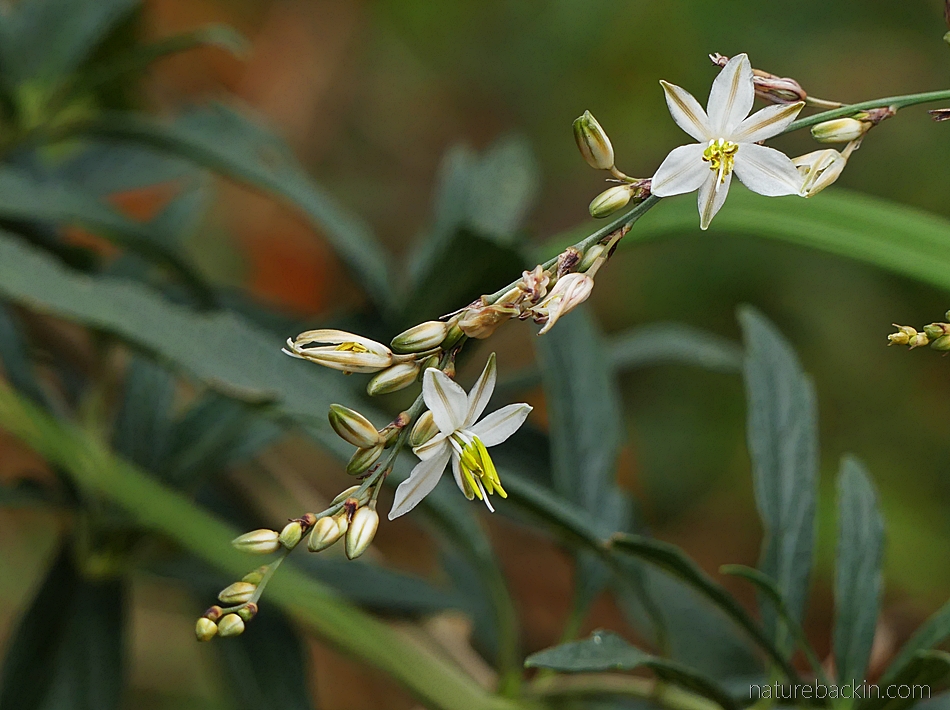
The dainty flowers of one of the 38 Chlorophytum species that are found in South Africa. They are commonly known as hen-and-chickens or spider plants
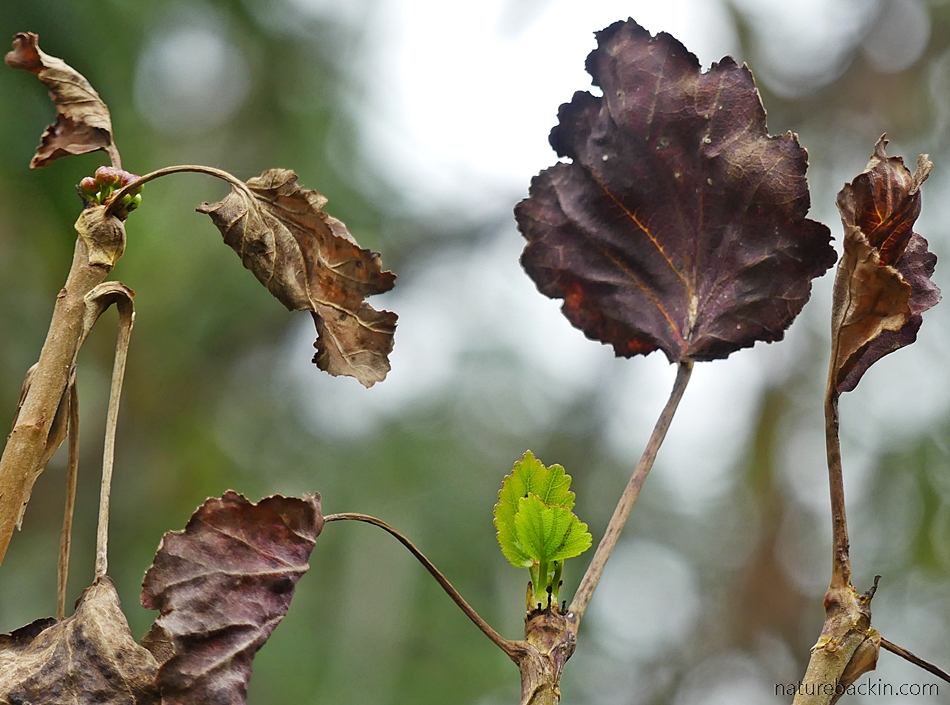
A precocious green shoot amongst dry winter leaves on a Natal Bottlebrush (Greyia Sutherlandii), which is one of the first plants to flower in late winter into early spring. A small coronet of flower buds can be seen developing at the top of the stalk to the left of the photo
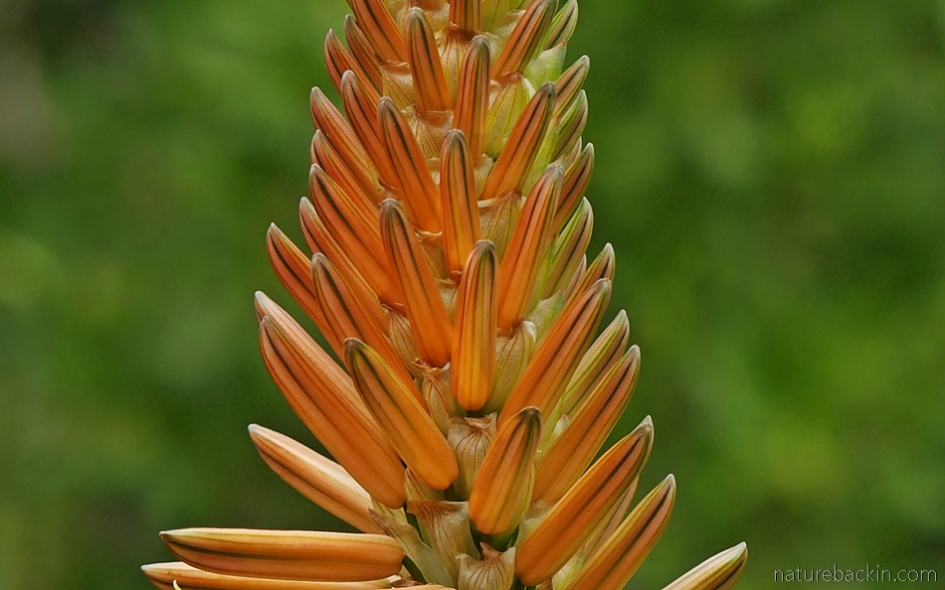
Unopened slightly striped flowers on the conical raceme of a van balen’s aloe or crawling octopus plant (Aloe vanbalenii)
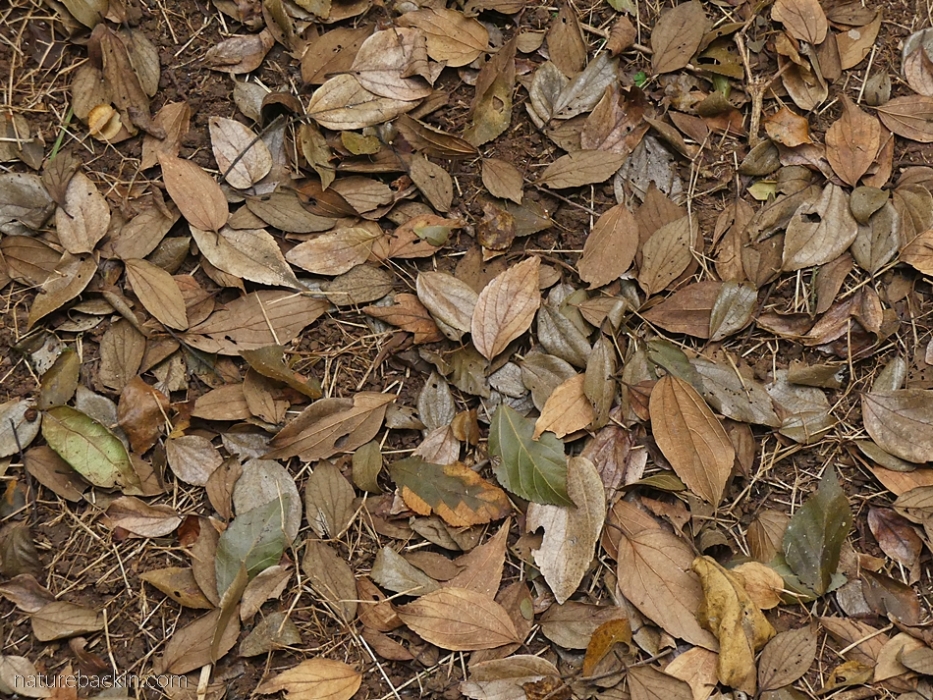
Fallen leaves, mostly of the white stinkwood (Celtis Africana) softly carpeting the ground forming a natural mulch
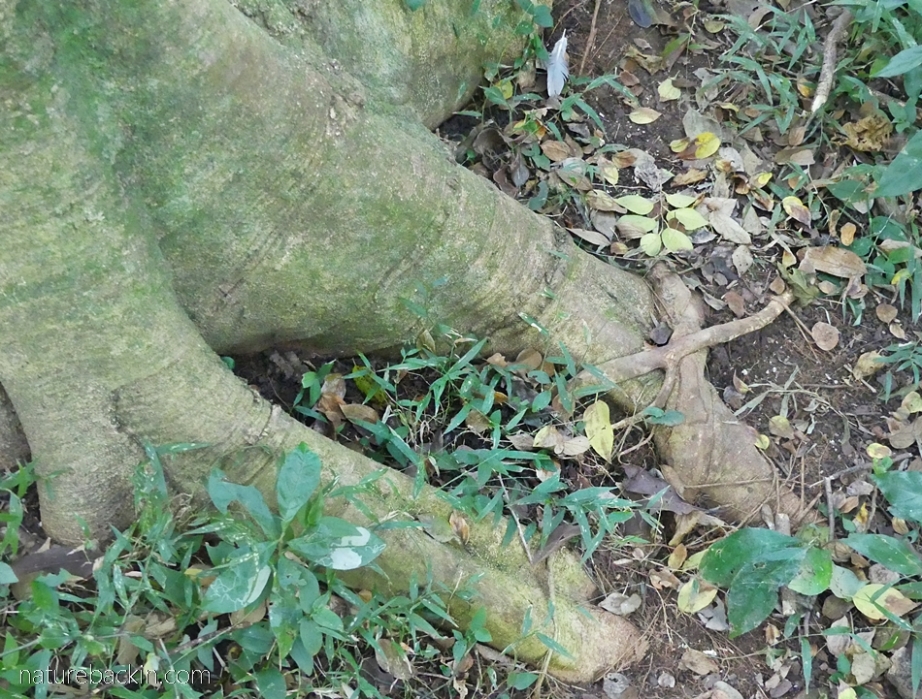
The roots at the base of the slightly fluted trunk of a white stinkwood tree
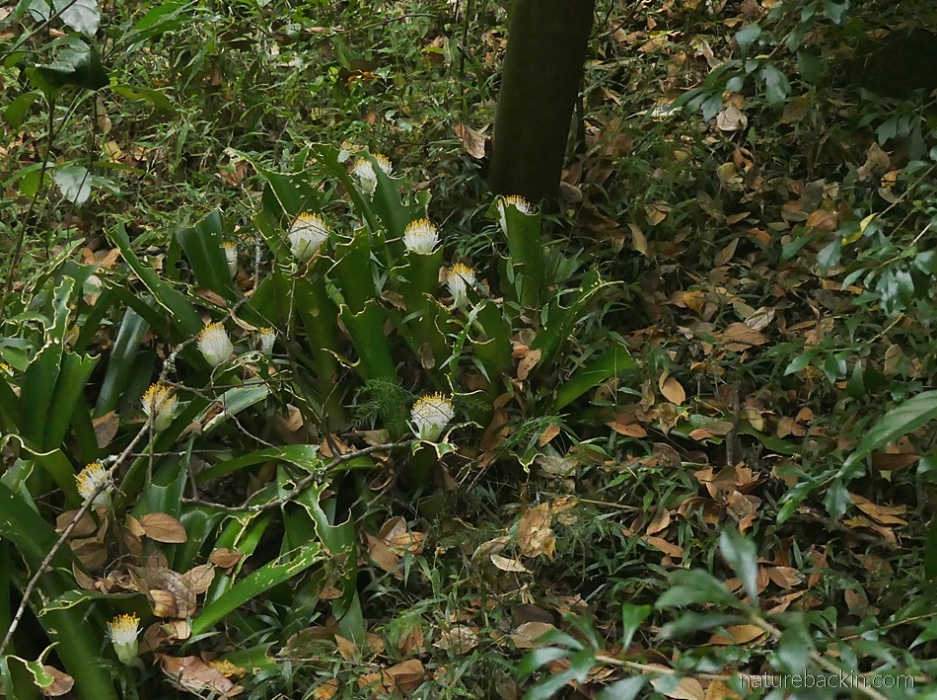
Despite their leaves still showing evidence of being munched by the large number of koppie foam grasshoppers that emerged in the garden in late summer, the white paint brush (Haemanthus albiflos) plants growing under the trees in our mini woodland still produced their lovely flowers
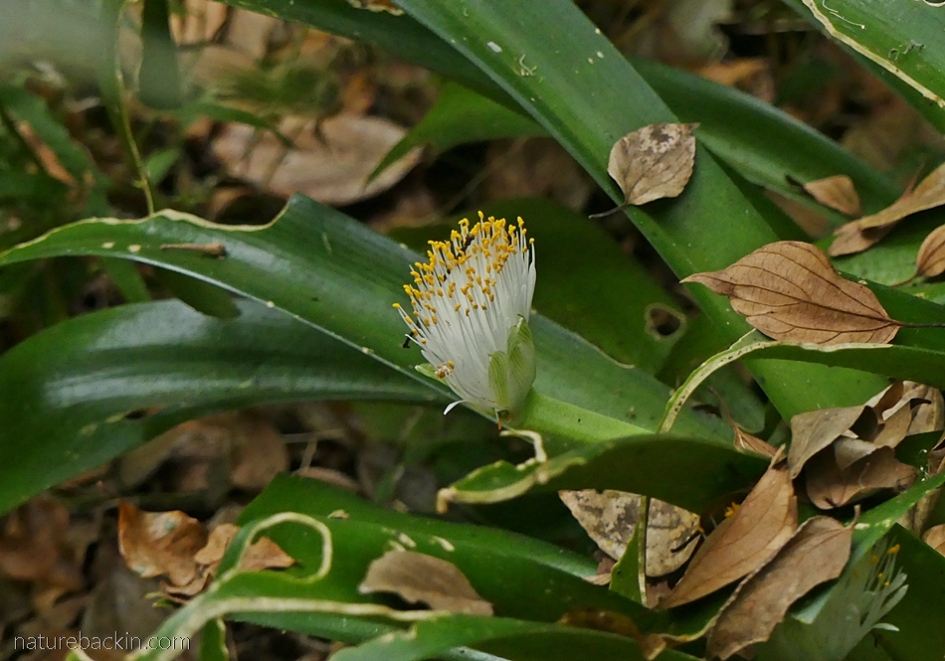
It is obvious from the flower why the shade loving Haemanthus albiflos is known as the white paint brush
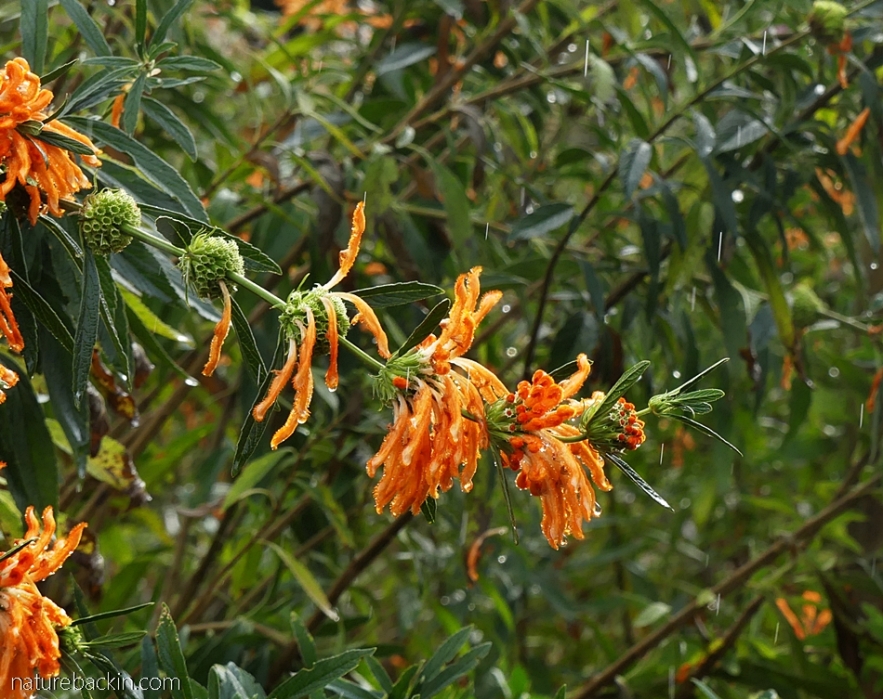
The normally erect Wild Dagga (Leonotus leonurus), past its best with the flowers starting to go to seed, is bowing down under the weight of the rain. The rain drops still falling this morning resemble small needles in the photograph
We live in a subtropical zone and winter solstice does not have the same resonances as it does in colder climates such as in northern regions of Europe. Apart from the fact that our winter temperatures are relatively mild, the difference in the day length between winter solstice and summer solstice is not all that marked. The difference is only 3 hours 48 minutes, whereas in London, UK, for example, the difference is 8 hours 49 minutes.
To extend the comparison, here in KZN winter solstice sunrise is at 06.52 and sunset is at 17.07 in June, and in London winter solstice sunrise is at 08.03 and sunset is at 15.53.
Summer solstice sunrise here is at 04.55 and sunset is at 18.58 in December, and in London summer solstice sunrise is at 04.43 and sunset is at 21.21 in June (source https://www.timeanddate.com/).
So although we don’t have any rituals to celebrate winter solstice, to my knowledge at any rate, the shortest day and the longest night of the winter solstice do mark a turning point where we can look forward to longer days and the prospect of spring ahead.
Currently, the Covid-19 pandemic is yet to peak in South Africa. Projections are that infection rates and the number of deaths will peak in the worst affected Western Cape late in June. How things escalate in other provinces is less clear at this stage. However, as the winter pivots at solstice, we can hope that the pandemic pivots too and that eventually we can look forward to brighter days.
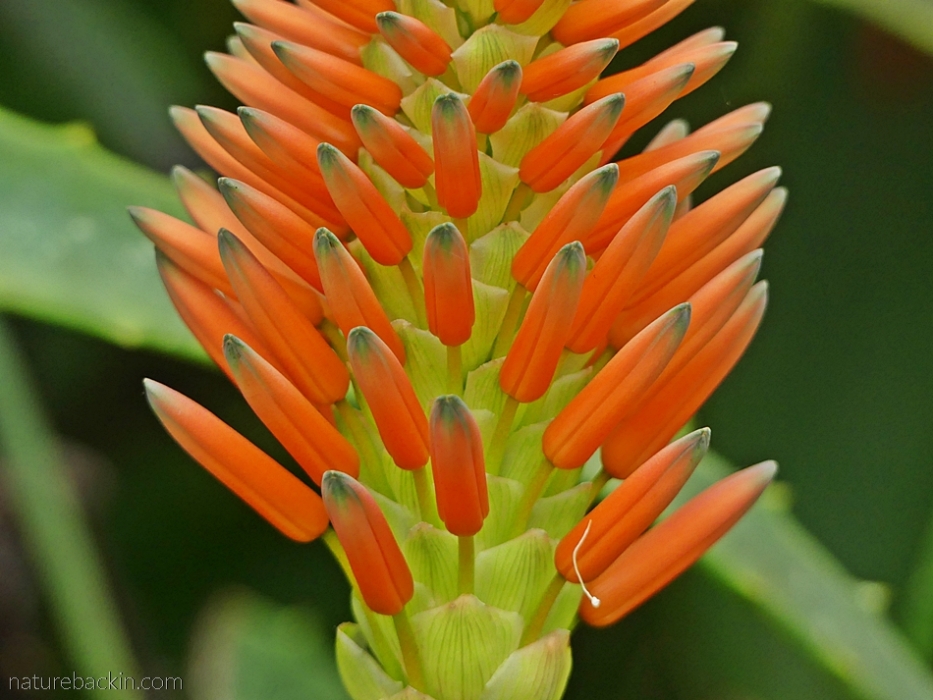
Posted by Carol

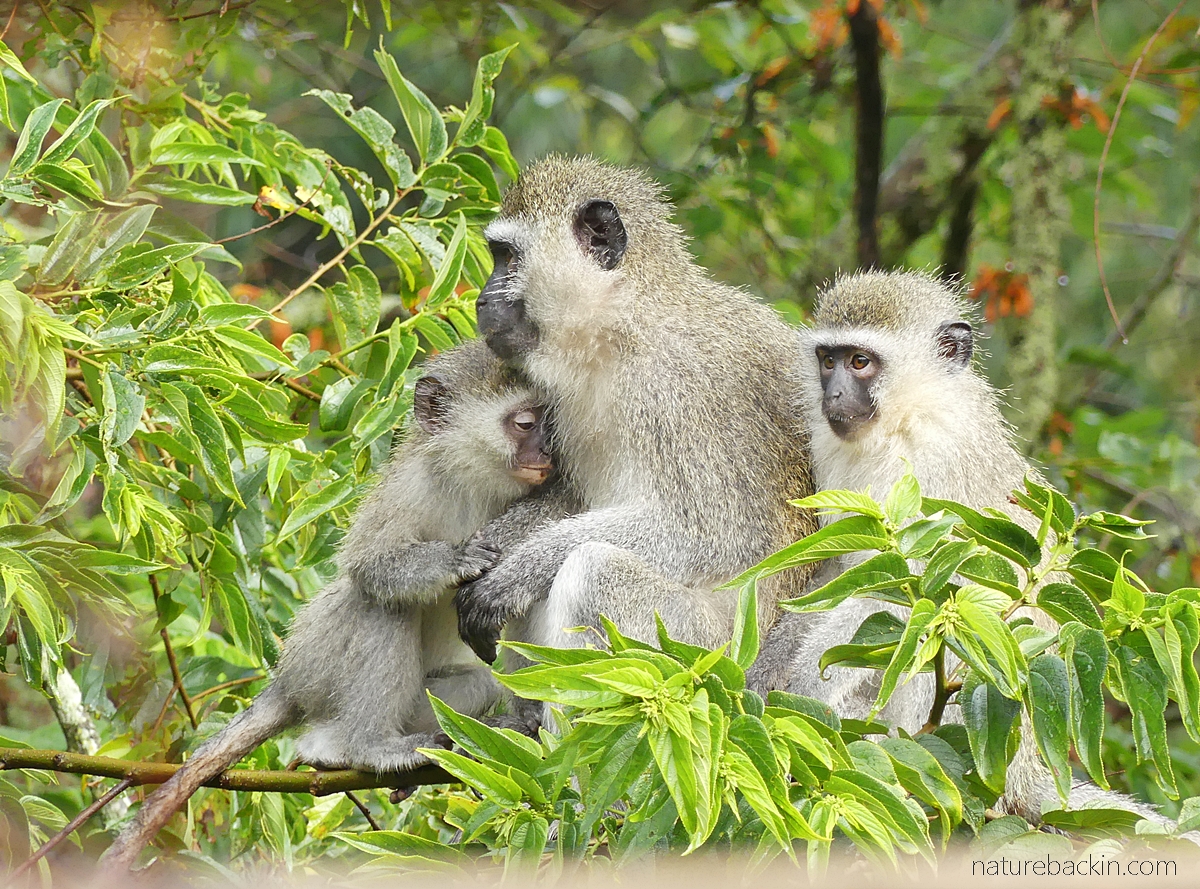







June 26, 2020 at 12:57 pm
Coming late to this post, Carol, I found it wonderfully calming. It’s actually cool and cloudy here right now after a few days of very hot weather which is continuing in the south-east of the country, but thinking of your mid-winter and enjoying your lovely photographs has been soothing and restful after a challenging week. I have always loved vervet monkeys, partly because of their photogenic poses, and you have some beauties here. As for the pandemic, we watch as the beaches grow increasingly crowded along with the roads. Tourism opens up here very soon which is much-needed for the cornish economy but it remains to be seen what the consequences might be. Take good care and continue to look forward to brighter days. They will come, and it serves no purpose to think otherwise 😊
LikeLiked by 1 person
June 28, 2020 at 6:51 pm
Thank you Sandra. I am happy the post was calming and you also love vervets. We have read some reports on the beach overcrowding, not to mention the tons of litter the crowds left behind. Can only hope for greater moderation and respect from visitors going forward. Hope Cornwall has a quieter reopening. You take care too – thank you.
LikeLiked by 1 person
June 24, 2020 at 6:24 am
Your winter, our summer; the days are long in England now. I went out at 4:15am this morning and it was already light, although before dawn.
I love the white paintbrush. There is an unrelated flower in Canada called ‘Indian paintbrush’ which is a vivid red, but yours looks much more like a real paintbrush.
I hope that covid-19 is brought swiftly under control. Restrictions are being eased in England, for now, although they may be reintroduced if cases start to rise again.
LikeLiked by 1 person
June 26, 2020 at 7:57 pm
Enjoy your lovely long days and bright early mornings. Our mornings are perceptibly starting to lighten earlier already.
That paintbrush flower is lovely, and they light up the shady understorey.
Easing of restrictions is a mixed blessing and like walking a tightrope. It is even more problematic when some people don’t seem concerned about spreading the virus, although of course for many it is almost impossible to practice social distancing etc, whether at home, on public transport or at work. I am trying to be hopeful although the next few weeks/months will be especially tough. Take care.
LikeLiked by 1 person
June 22, 2020 at 2:36 pm
Yes, here’s to brighter days. Your garden offers a splendid array for this time of the year. The aloes along the R67 in the Eastern Cape have never looked so bright, so orange, so beautiful. Let’s hope they are a harbinger of better times
LikeLiked by 1 person
June 22, 2020 at 8:18 pm
Indeed, let’s hope so.
LikeLiked by 1 person
June 22, 2020 at 5:23 am
Beautiful pics Carol – love the close ups of the aloes. The cold here in Dundee has been extreme! The black frost arrived last week and left a trail of destruction. Fortunately the days are lovely and sunny on the veranda so there is some respite. Your garden must be such a source of joy and distraction to you during these times. Thank you for sharing your lovely and informative posts.
LikeLiked by 1 person
June 22, 2020 at 8:18 pm
Thanks Carol. Ooh too bad about the black frost. We have only ever experienced that once here some years back. So far no frost where we are this winter, but it had gone down to zero during the previous cold spell. Very unusual for here. We are lucky to have sunshine during most days, even though the nights are chilly.
Keep warm!
LikeLiked by 1 person
June 22, 2020 at 3:14 am
I’ll try one more time…. sigh… WordPress is being obnoxious. I suppose the main thing I said in a comment WP rejected was that the vervet monkeys are beyond cute.
The rest of the lengthy comment I lost was the usual comparison of our seasons which I still find fascinating.
LikeLiked by 1 person
June 22, 2020 at 8:15 pm
I have had comments disappear on occasion too. Not sure why. Thanks for trying one more time!
Yes the vervets are very cute.
I hope you had a good solstice and you have good summer weather ahead.
LikeLike
June 23, 2020 at 3:59 am
It might be some WP glitch or perhaps me hitting the wrong button. I just call it gremlins. 😀
Thanks for the reminder about solstice. I must savor the longer days of daylight as we once again turn to some shorter daylight hours.
It also occurs to me that I might just dread summer (our dry season) because of the ever present threat of wildfire. The southern California coast is already having some outbreaks. It would sure be nice to skip the wildfires this summer while we struggle with the pandemic and political turmoil.
LikeLiked by 1 person
June 23, 2020 at 4:57 pm
I understand that sense of dread. And yes there is enough turmoil without outbreaks of further fires. Can only hope that any fires can be contained.
LikeLike
June 20, 2020 at 4:00 am
As a kid, I had trouble wrapping my head around the idea that seasons were opposite in the southern hemisphere. How can it be cold when I’m in shorts? And more to the point, how can it be Christmas when they’re going to the beach and swimming?
The photos are lovely as always. Love the monkeys and how expressive they are. The variety in your garden makes me think you must live on 40 acres!
Take care and enjoy the lengthening days.
LikeLiked by 1 person
June 20, 2020 at 8:02 pm
Here when I was a child – it amazed me that during our hot summers at Christmas time shop windows would be decorated with cotton wool snow and paper snow flakes!
I also love the monkeys – they really are so expressive, and they are endlessly engaging to watch.
Our garden is about 3/4 of an acre. The large stinkwood tree is actually just outside our fence in the area between the back of our garden and the commercial plantation beyond, so strictly speaking it is not actually in our garden. Bit of poetic licence I employed there 😊
You take care too, and I hope you have many an enjoyable swim and snorkle in the sea during the months of summer still ahead.
LikeLiked by 1 person
June 21, 2020 at 4:30 am
My old garden in Washington State was only on a 50×100 foot lot (including the house), but it made use of large trees in our neighbors’ yards to provide large anchor points. The, not long after we left, one neighbor cut down one of the trees. I’m glad I wasn’t there to see that.
LikeLiked by 1 person
June 21, 2020 at 1:02 pm
Sorry to hear about the loss of the tree even though you were not there to see it.
LikeLiked by 1 person
June 19, 2020 at 11:35 am
Thank you so much for your lovely and captivating photography Carol. Beauty at its marvellous best. Great post👌👌👌👌👌
LikeLiked by 1 person
June 20, 2020 at 7:52 pm
Thank you for your kind comment Kamal. We are lucky to have cheerful flowers even during the winter months,
LikeLike
June 21, 2020 at 3:54 am
You are always welcome dear Carol♥️♥️🙏🙏
LikeLiked by 1 person
June 19, 2020 at 9:25 am
Lovely observation Carol, thank you! We’ve had a much colder winter here this year so far, several morning the birdbath is completely frozen, the first time in May… So I am happy that the days will start getting longer again, even though it will be colder for a couple of months, it creates a more optimistic brighter feeling. xxxx
LikeLiked by 1 person
June 20, 2020 at 7:50 pm
It has been surprisingly cold especially for so early in the season – the frozen birdbath you describe is an undeniable indicator! Yes, even when the weather is cold, the lengthening days make such a difference. Keep warm as the season starts to turn …
LikeLiked by 1 person
June 19, 2020 at 5:39 am
I think I would feel very at home in your garden. We have been ‘cheated’ this year for the canary creepers only blossomed for about a week, the Cape Honeysuckle has not put on a brave show either, so the aloes have to do their bit to brighten the garden. Your photographs are always a joy to see.
LikeLiked by 1 person
June 20, 2020 at 7:47 pm
Thank you Anne. I think you would feel at home in our garden and wouldn’t mind its scraggly bits (which are many!). That is strange about the canary creeper blossoming for such a short time – it has had a good season here this year, although the Cape Honeysuckle not so much. We have a few aloes in the garden and they are such bright spots quite literally.
LikeLike
June 19, 2020 at 5:32 am
Lovely photos, as ever, highlighting how colourful your winter is compared with ours. And this weekend your days will start to lengthen as ours shorten. I always find the day after the solstice depressing for this reason. And this year, we all have reasons not to be cheerful. Hoping that you and all you are close to continue to stay well – we all seem to be in for the long haul.
LikeLiked by 1 person
June 20, 2020 at 7:38 pm
As I commented to Eliza, I did feel a bit guilty talking about us looking forward to lengthening days, when I know it is the opposite in the northern hemisphere. However, you do still have July and August ahead of you. But as you say we all have reasons not to be cheerful during these times. It can help to find and acknowledge sources of solace and support, such as spending time in nature if we can, which can help buoy us up.
We do seem to be in for the long haul, and we all need to find stamina to keep us going. I hope you and yours continue to stay well too and you are able to keep in touch at least virtually with all your family until you are able to meet for real once again. Take care.
LikeLiked by 1 person
June 21, 2020 at 7:50 am
You too. That early optimism about the advantages to us personally , and to the planet seem to be dissipating as – here at least – the New Normal goes on and on, and out on the roads the cars are inexorably reappearing in force. But so long as we all stay well …. Today is our longest, your shortest day. Let’s enjoy it for different reasons!
LikeLiked by 1 person
June 21, 2020 at 1:06 pm
Here too cars seem to be back in almost full force. On one of our rare outings by car yesterday one change we did notice is the increased number of people out jogging and walking in the suburbs – perhaps they caught the habit during the more stringent weeks of the lockdown.
Best happy solstice wishes to you too.
LikeLiked by 1 person
June 19, 2020 at 3:10 am
Captivating photos, Carol, some I see here in California. Love your close-ups. And your vervets! Stay safe. Things are bad here, too, as you know. Looking forward to brighter days ahead.
LikeLiked by 1 person
June 19, 2020 at 8:40 pm
Thanks so much Jane. I think there are several South African plants that have made themselves at home in California. Aren’t the vervets just so beautiful 😊
And you stay safe too through these very tough times.
LikeLiked by 1 person
June 19, 2020 at 2:10 am
Amen to you closing paragraph, Carol. Amen.
Your garden still is a joy to behold, even as the middle of winter approaches rapidly.
This winter seems to be extraordinarily cold. For the first time in the 13 years I’ve lived in Pretoria our bird baths froze over during two nights last week. I don’t like winter at all, we only get the cold and no snow as reward!
Conventional wisdom up here holds that a cold winter promises a wet summer. Good that for keeping the Vaal Dam full.
LikeLiked by 1 person
June 19, 2020 at 3:08 pm
A frozen birdbath indicates just how cold it is! Brr. It has not been that bad here. I recall only one winter some time back when that happened here. I also am not keen on cold weather, but at least on most days midday in a sheltered sunny spot can be okay. But even that was not possible this week as there is such a chill in the air even when it is not overcast.
I hope there is truth in the convention that a cold winter heralds a wet summer, and yes, we can also hope that eventually we will all have a brighter future ahead. Take care, stay safe and keep warm.
LikeLiked by 1 person
June 19, 2020 at 1:39 am
Gorgeous photos, Carol– I esp. love the aloes.
I always have mixed feelings about our summer solstice… while it is the start of summer, which I LOVE, it is also when the days grow shorter, leading to the dark and frigid days of winter.
Currently, the long days are a boon for the birds raising their broods. The first bird sang at 4:10 this morning, with the cacophony of the dawn chorus peaking about a half hour later. So loud, yet most welcome!
Have a nice winter solstice, I hope the sun comes out for you. Will you be able to see the solar eclipse?
LikeLiked by 1 person
June 19, 2020 at 3:04 pm
Thank you Eliza. I admit to a twinge of guilt talking about how our solstice pivots us towards summer, knowing that it is the opposite for everyone in the north. But at least you still have the best months of summer still to appreciate.
The early dawn chorus you describe sounds wonderful – what a fantastic start to the morning.
I gather that much of Africa will be able to see the solar eclipse, but it will not be visible from South Africa. I hope that you are able to see it, and have a lovely summer soltice.
LikeLiked by 1 person
June 19, 2020 at 5:58 pm
Supposedly, the eclipse is visible in Asia and Africa, but for the rest of us, we can watch it online! Modern times. 😉
LikeLiked by 1 person
June 18, 2020 at 10:48 pm
Hello Carol,
As always, it is a real pleasure to view your stunning photographs and read your thoughtful writing. We are about to arrive at summer solstice this coming weekend, and like you, I hope the pandemic will pivot and we can look forward to brighter, healthier days. I love all the photos in this series, but the first shot especially touched me. Hope you and all your dear ones continue to take care.
In friendship,
Takami
LikeLiked by 2 people
June 19, 2020 at 2:56 pm
Hi Takami. Thanks for writing. I hope you are able to get some enjoyment out of your summer even in the face of the pandemic, and I also hope that you and yours are well and that you continue to stay safe.
I also found seeing the monkeys drawing comfort from each other very touching, especially the little one and its mother.
You have also captured some wonderful moments of maternal care and affection in your waterbird photos.
With best wishes, Carol
LikeLiked by 2 people